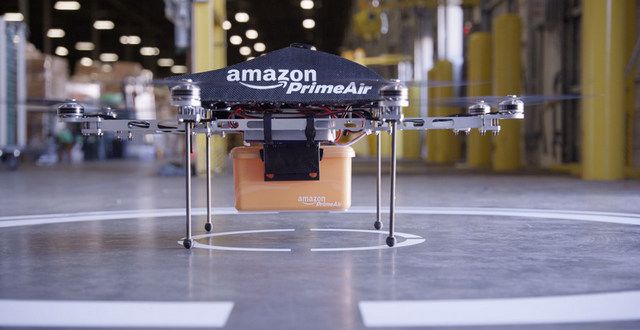Amazon isn’t the first to hitch itself to drones, watch the skies for a DomiCopter
Drones – unmanned small aircraft that are typically flown remotely – have always been talked about in two contexts. One, in the American war on terror where they were used for assaults in tough terrains in Afghanistan and Iraq without loss of American lives; and two, in sci-fi movies and books.

And then, Amazon founder Jeff Bezos appeared on the popular show ‘60 Minutes’ on the CBS network a couple of days ago to unveil ‘Amazon Prime Air’ drones meant for delivery. The short clip shows a man placing an order and choosing 30 minute delivery, with the order being fulfilled by a drone dropping the package off at his doorstep. The drone is able to deliver packages of up to 5 pounds (2.2 Kilograms) and make round trips of up to 10 miles (16 Kilometers). Given the package size, it is estimated that nearly 86% of all the goods that Amazon carries, will fit within the stipulated weight range.
Well, Amazon definitely is not a pioneer in thinking of using drones for delivery – they have already been used to deliver Tacos (TacoCopter) and even in the pioneer of 30 minute delivery industry, pizza by Dominos (DomiCopter) in various test runs. A Chinese logistics provider SF Express has also been testing package delivery using drones in highly congested areas. But what Amazon brings to the problem is abundance of manpower, money and a long term view. They are famously known to work on projects that have a 7-year horizon and might not have an immediate payoff.
So how does this push their goal of being the world’s largest retailer forward?
- These drones might not be used in heavily populated areas such as New York City or downtown Chicago due to security reasons. But it definitely opens up avenues to reach far-flung suburbs and even rural areas where a truck can go in with 5-6 drones and maybe fulfil dozens of orders from one place, replicating a mini hub-and-spoke model.
- With companies developing better cameras and even smarter systems to man these drones, the ability to manage fleets of drones from centralized locations saves millions of dollars in cost.

But this is still some way away from becoming a reality. A few weeks ago, US’s Federal Aviation Administration (FAA) released a roadmap and privacy policy on the path to creating a policy framework for anticipated use of drones for domestic purposes. They expect nearly 30,000 drones to be in the skies by 2020 and have already issued 313 domestic drone licenses, mainly to government agencies.However, there are a few (not so minor) problems that have to be addressed before we can have our drone deliveries:
- Safety – Although companies such as Amazon are promising that the drones will comply with commercial aviation standards, that doesn’t really make anyone feel safe. What if the software malfunctioned and fell on someone’s head? What if the package dropped?
- Privacy – Most drones have a camera that doubles up as their ‘robotic eye’. Whether we want it or not, most drones will end up shooting videos of the earth. What is the footfall at a certain location at a certain time of day? Which is the ethnicity of a specific neighbourhood mall’s frequent visitors? Who lives where and does what? This is a privacy activist’s worst nightmare come true.
- Security – I can imagine cocaine dealers eagerly awaiting the drones as a new delivery mechanism. What about terrorists using them to disperse aerosolized chemical weapons over a densely populated area?
The earliest that this technology can be commercialized and used is 2015, according to the most optimistic estimates. Did Amazon resort to this as a PR gimmick because they have been flooded with negative media reports because of a BBC undercover operation that showed Amazon employees working in conditions that might result in physical and mental illnesses or because of their tax avoidance case? The timing is too perfect as well – just before the holiday festive sales. It leaves us wondering if this was just coincidence.
In the end, like most technologies, the limitations are not with the technical capability, but with human adoption and safe usage. So whether you want to order from Flipkart or Myntra here in India or expect a 30-minute drone delivery for which you’ll have to wait till 2016, you take a call.







